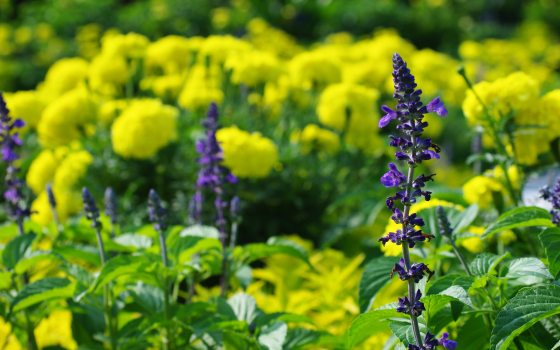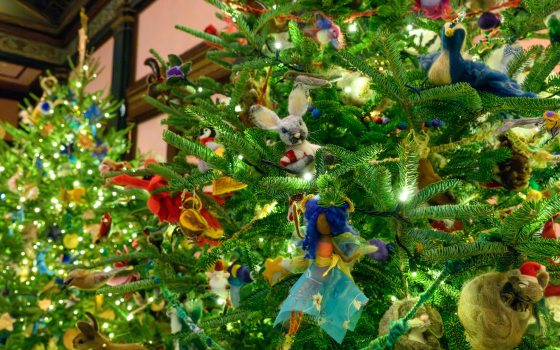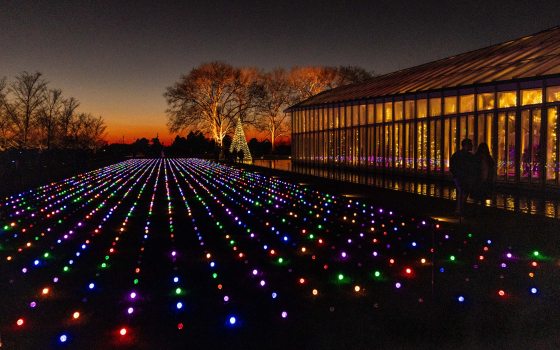From high temperatures to seemingly unrelenting humidity, summer has been quite fierce this year. Having grown up and started my career in horticulture in the heat and humidity of St. Louis, Missouri, this summer has brought me back to my teenage years of working at a local greenhouse, desperately trying to get all of the plants watered only to repeat the process a second time by afternoon. With summers ranging hotter each year in our area, it’s important to choose the right annual flowers that can withstand heat and humidity. Having designed annual displays now for almost a decade, I have my own mental list of which plants can do so, and last until fall. Follow along as I share my favorites—including those you can see in the Gardens right now and what to consider for your own home garden.
When you think of summer flowers, it’s important to consider the differences between summer plants that thrive in hot summer climates versus those that prefer mild summer temperatures. For example, petunias, geraniums, calibrachoa, hybrid verbena, and dahlias prefer more mild summer temperatures. They often decline or struggle in July and August when the heat of summer is at peak, often rebounding by mid-September when evening temperatures begin to cool. By comparison, Salvia, lantana, impatiens, and many common tropical plants struggle in May if temperatures remain too cool but take off when temperatures warm by July.
When planning our displays, we look to incorporate a selection of annuals that thrive throughout the summer and can adapt to varying conditions. Among those that love heat and humidity are Salvia. These magnets for butterflies, bees, and hummingbirds include a variety of colorful gems that put on a floral show from summer to fall. Salvia ‘Amistad’ is a gorgeous purple flowering salvia that grows to 4 feet tall. This plant can get quite tall and wide, and may need staking support. Salvia ‘Amistad’ can be found growing in the Combination Garden in the Idea Garden.

Salvia ‘Amistad’. Photo by Patrick Greenwald.
Salvia splendens 'Van Houttei' is a burgundy selection currently growing in the Square Fountain Garden. Also found in the Square Fountain Garden is the raspberry-purple flowers of Salvia ‘Wendy’s Wish’. With a little deadheading, the flowers can bloom from early summer to the first frost. Preferring full sun, it can also tolerate a little shade. A popular bedding plant, Salvia farinacea is a shorter salvia typically planted near the front of a border, ranging in colors from blue, white, and bicolor. Deadheading will promote continual blooms over summer. Salvia 'Mysty', a hybrid of Salvia longispicata × farinacea, is also a great compact salvia that can be found growing around the Round Fountain on Flower Garden Walk.
Salvia oxyphora is one of the most tropical-looking salvias we plant outdoors in summer at Longwood Gardens. The fuzzy bubblegum pink flowers are contrasted by their deep green leaves. Another salvia that can tolerate a little shade, these plants come alive at the end of summer, putting on a glorious display until the first front. Salvia oxyphora can be found growing in the Combination Garden in the Idea Garden.

Salvia oxyphora. Photo by Patrick Greenwald.
Going beyond Salvia, Pentas boast star-shaped flowers that shine all summer long. Among my favorites are Pentas lanceolata‘ Ruby Glow’ and ‘Nova’: these are not your typical bedding plant Pentas, but rather varieties that grow 2 to 3 feet tall. ‘Ruby Glow’ flowers are a rich red, and ‘Nova’ a magenta pink.

Pentas lanceolata ‘Nova’. Photo by Patrick Greenwald.
A true nectar factory, butterflies, hummingbirds and bees love Pentas, which prefer full sun to part shade. When establishing Pentas, be careful not to water the foliage in the heat of the day. Water on the leaves can burn the leaves in full sunlight, especially if plants were not acclimatized to full sunlight conditions. It is important to only water the roots, and limit foliage getting wet. Pentas lanceolata ‘Ruby Glow’ can be found this year growing along Flower Garden Drive underneath the canopy of bald-cypress trees (Taxodium distichum). Pentas lanceolata ‘Nova’ can be found both in the Square Fountain Garden and in the pink border garden along Flower Garden Walk.

Pentas lanceolata ‘Ruby Glow’. Photo by Patrick Greenwald.
A favorite of mine and of hummingbirds, Cuphea 'Cupver' Vermillionaire® feature orange and yellow tubular shaped flowers that are especially beautiful paired up with purple flowering annuals. Growing usually under 2 feet tall, these cuphea prefer full sun, well drained moist-average garden soil. You can find these beauties in the Square Fountain Garden this summer.

Cuphea 'Cupver' Vermillionaire® shine in the Square Fountain Garden. Photo by Patrick Greenwald.
Nothing says summer more than a landscape planted in tropical Alocasia and Colocasia (elephant’s-ears). These fast-growers love moisture and should be watered during dry times in summer. They add great structure to an annual display garden, and can provide a bit of shifting shade, keeping the plants growing beneath their large leaves a bit cooler during the heat of summer. This Year, Alocasia ‘Sarian’ can be found in the Square Fountain Garden.

Alocasia ‘Sarian’ in the Square Fountain Garden. Photo by Patrick Greenwald.
I remember when the first sun-tolerant SunPatiens® New Guinea Impatiens made their debut almost two decades ago. Perfect for full sun to part shade gardens, these everblooming flowers thrive in the hottest temperatures of summer and prefer moist soil. Stroll down Flower Garden Walk and check out how well the SunPatiens® ‘Compact Electric Orange’ are doing in the red border gardens. Other New Guinea impatiens varieties prefer part sun-shade conditions and perform beautifully in a woodland garden setting.

Impatiens 'SAKIMP011' (SunPatiens® Compact Orange) New Guinea Impatiens. Photo by Patrick Greenwald.
A staple of a summer annual garden, lantana come in purple, pink, orange, yellow, and all the colors in between, and love the hot, dry weather of summer. Once established, they are some of the most drought-tolerant annuals on my list. Just make sure a lantana is established before holding back on watering. Many varieties of lantana can be found along Flower Garden Walk; some stay short and compact, and others require a lot of summer pruning to keep the plants under 2 feet tall and wide. Some, like Lantana camera ‘Athens Rose’ have even been trained into a single stem standard form (tree-like form) over 6 feet tall.

Lantana camera ‘Athens Rose’. Photo by Patrick Greenwald.
Known for their colorful foliage and flowers, cannas provide a tropical feel to any full sun garden. Preferring moist to average garden soil, they may need supplemental irrigation during dry weeks. In late June into July, Japanese beetles can be a pest problem best managed by early morning scouting with a bucket of soapy water to collect the sleepy beetles before they become active in the heat of the day.
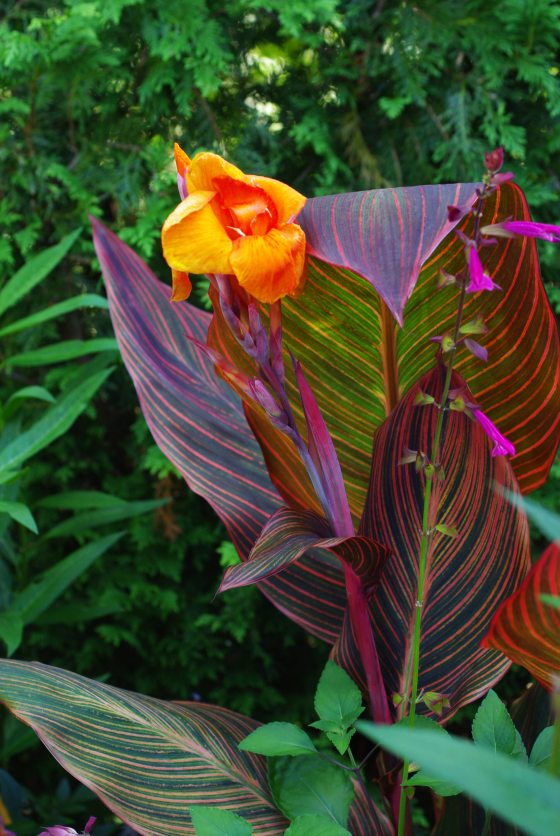
This year, you can find Canna ‘Phasion’ Tropicanna® in the Square Fountain Garden. Photo by Patrick Greenwald.
Another annual that thrives when the temperatures get hot, a few varieties of purple, pink and white gomphrena, including Gomphrena globosa ‘Audray White’ can be found growing at the Rose Arbor and Flower Garden Walk, and in the Annual Corridor in the Idea Garden.
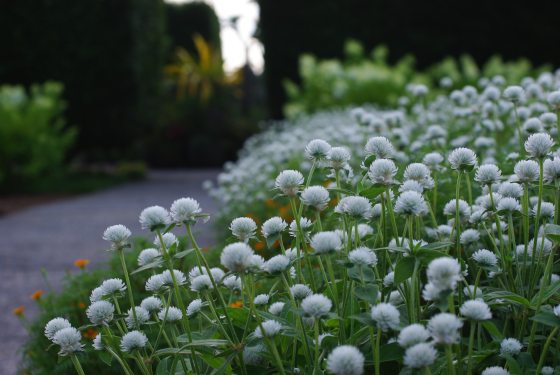
Gomphrena globosa ‘Audray White’. Photo by Patrick Greenwald.
When planning your annual flowers for summer, be sure to choose plants tolerant of heat and humidity … so that even if you may be wilting from the summertime heat, your flower garden will be thriving.
